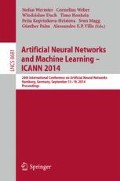Abstract
Several computational models have been designed to help our understanding of the conditions under which persistent activity can be sustained in cortical circuits during working memory tasks. Here we focus on one such model that has shown promise, that uses polychronization and short term synaptic dynamics to achieve this reverberation, and explore it with respect to different physiological parameters in the brain, including size of the network, number of synaptic connections, small-world connectivity, maximum axonal conduction delays, and type of cells (excitatory or inhibitory). We show that excitation and axonal conduction delays greatly affect the sustainability of spatio-temporal patterns of spikes called polychronous groups.
Access this chapter
Tax calculation will be finalised at checkout
Purchases are for personal use only
Preview
Unable to display preview. Download preview PDF.
References
Fuster, J.M., Alexander, G.E., et al.: Neuron activity related to short-term memory. Science 173(3997), 652–654 (1971)
Miyashita, Y.: Neuronal correlate of visual associative long-term memory in the primate temporal cortex. Nature 335(6193), 817–820 (1988)
Funahashi, S., Bruce, C.J., Goldman-Rakic, P.S.: Mnemonic coding of visual space in the monkey’s dorsolateral prefrontal cortex. Journal of Neurophysiology 61(2), 331–349 (1989)
Wang, X.J.: Synaptic basis of cortical persistent activity: the importance of nmda receptors to working memory. The Journal of Neuroscience 19(21), 9587–9603 (1999)
Machens, C.K., Romo, R., Brody, C.D.: Flexible control of mutual inhibition: a neural model of two-interval discrimination. Science 307(5712), 1121–1124 (2005)
Mongillo, G., Barak, O., Tsodyks, M.: Synaptic theory of working memory. Science 319(5869), 1543–1546 (2008)
Szatmáry, B., Izhikevich, E.M.: Spike-timing theory of working memory. PLoS Computational Biology 6(8), e1000879 (2010)
Ioannou, P., Casey, M., Grüning, A.: Evaluating the effect of spiking network parameters on polychronization. In: Villa, A.E.P., Duch, W., Érdi, P., Masulli, F., Palm, G. (eds.) ICANN 2012, Part I. LNCS, vol. 7552, pp. 255–263. Springer, Heidelberg (2012)
Qin, S., van Marle, H.J., Hermans, E.J., Fernández, G.: Subjective sense of memory strength and the objective amount of information accurately remembered are related to distinct neural correlates at encoding. The Journal of Neuroscience 31(24), 8920–8927 (2011)
Izhikevich, E.M.: Polychronization: computation with spikes. Neural Computation 18(2), 245–282 (2006)
Izhikevich, E.M., et al.: Simple model of spiking neurons. IEEE Transactions on Neural Networks 14(6), 1569–1572 (2003)
Sjöström, J., Gerstner, W.: Spike-timing dependent plasticity. Scholarpedia 5(2), 1362 (2010)
Swadlow, H.A., Waxman, S.G.: Axonal conduction delays. Scholarpedia 7(6), 1451 (2012)
Watts, D.J., Strogatz, S.H.: Collective dynamics of ‘small-world’ networks. Nature 393(6684), 440–442 (1998)
Shepherd, G.M.: The Organization of the Brain. Oxford University Press (2004)
Author information
Authors and Affiliations
Editor information
Editors and Affiliations
Rights and permissions
Copyright information
© 2014 Springer International Publishing Switzerland
About this paper
Cite this paper
Ioannou, P., Casey, M., Grüning, A. (2014). Factors Influencing Polychronous Group Sustainability as a Model of Working Memory. In: Wermter, S., et al. Artificial Neural Networks and Machine Learning – ICANN 2014. ICANN 2014. Lecture Notes in Computer Science, vol 8681. Springer, Cham. https://doi.org/10.1007/978-3-319-11179-7_91
Download citation
DOI: https://doi.org/10.1007/978-3-319-11179-7_91
Publisher Name: Springer, Cham
Print ISBN: 978-3-319-11178-0
Online ISBN: 978-3-319-11179-7
eBook Packages: Computer ScienceComputer Science (R0)

